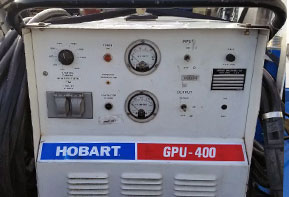Hobart is one of the most well-regarded ground power unit (GPU) producers on the market. Hobart, now known as ITW GSE, manufactures GPUs with a number of differentiating features that make them the first choice of many ground service providers. Here at FlyTek GSE, we have years of experience with Hobart ground power unit repair, which is just one reason we are your #1 Hobart maintenance and service provider.
Why Hobart?

Founded in 1946, Hobart was the first domestic US manufacturer of ground power units, and their quality has stood the test of time. A supplier for the military, commercial, general, and business markets, Hobart GPUs deliver both AC and DC power. Hobart manufactures the only solid-state frequency converter on the market that has 400 percent overload at the output.

Providing the best voltage regulation for an engine-powered ground power unit, Hobart GPUs also feature:
- High-coolant temperature shutdown;
- Low-coolant level shutdown;
- Over-frequency protection;
- Under-frequency protection; and
- Lost neutral detection, to name a few.
Hobart’s highly-customizable units offer a great deal of flexibility and mobility, along with the quality their reputation has been built on. Examples include mounting a GPU on a vehicle or utilizing a fifth-wheel style trailer assembly.
Easy setup, stringent safety features, and excellent reliability set Hobart ground power units apart.
Why FlyTek?
FlyTek GSE is the mid-Atlantic region’s number one provider of GSE maintenance and repair. Our customers know that they can rely on FlyTek to keep their operations working smoothly and to get them up and running swiftly in the case of an emergency.

At FlyTek, we’ve been providing Hobart ground power unit repair services since our inception. We understand the subtle differences that make a Hobart GPU unique, and that means we can provide fast, accurate repairs without costing you excess downtime.
We work on all brands of ground support equipment, and provide on-site services at your location. Jack load testing and certification, GPU and HPU maintenance programs, tug and tow bar repair, oil sampling and analysis, and more can be done without the hassle of sending your equipment out for service. And if you are in the market for additional equipment, we source and supply both new and used ground support equipment, including aircraft jacks, engine stands and slings, work stands and work platforms, and more. Contact us to discuss your specs, and we’ll recommend equipment in your price range that is optimal for your purpose.
Call FlyTek GSE today for a free consultation, and put our knowledge and resources to work for you.


